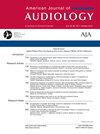婴儿听觉脑干反应测量行为阈值预测的校正因子评估和系统间比较
IF 1.8
4区 医学
Q3 AUDIOLOGY & SPEECH-LANGUAGE PATHOLOGY
引用次数: 0
摘要
目的通过校正听性脑干反应(ABR)阈值来估计婴儿的行为阈值。对校正结果进行了验证,并对不同系统的行为阈值估计值进行了比较,以便为加拿大安大略省的设备过渡和协议提供信息。方法在研究 1 中,进行了回顾性档案审查。将 84 名听力损失婴儿的 ABR 阈值估计值与行为阈值进行比较,以验证自 2016 年以来安大略省婴儿听力计划中应用的 ABR 校正的准确性。研究 2 检验了两种不同 ABR 系统估计 37 个成人耳朵和 105 个婴儿耳朵阈值的精度。结果经校正的 ABR 阈值预测婴儿的行为阈值平均在 1.77 dB 范围内(各频率平均值范围:1.18-2.26 dB)。如果考虑到耳道声学因素,各频率之间的平均差异会减小到 0.6 dB(范围:0.14 至 -1.23 dB)。安大略省婴儿听力计划中使用的 ABR 校正因子可准确预测听力损失婴儿的行为阈值。当不同 ABR 系统的校准和收集参数相似时,阈值估计值具有可比性,无需进一步调整校正因子。本文章由计算机程序翻译,如有差异,请以英文原文为准。
Correction Factor Evaluation and Between-System Comparison of Behavioral Threshold Predictions From Auditory Brainstem Response Measures in Infants.
PURPOSE
Auditory brainstem response (ABR) thresholds are corrected to estimate behavioral thresholds in infants. Corrections were validated, and a comparison of behavioral threshold estimates between systems was conducted to inform equipment transition and protocols in Ontario, Canada.
METHOD
In Study 1, a retrospective file review was conducted. ABR threshold estimates from 84 infants with hearing loss were compared to behavioral thresholds to validate the accuracy of the ABR corrections applied in the Ontario Infant Hearing Program since 2016. Study 2 examined the precision of two different ABR systems to estimate thresholds in 37 adult and 105 infant ears.
RESULTS
Corrected ABR thresholds predicted behavioral thresholds in infants to within 1.77 dB (range of mean values across frequency: 1.18-2.26 dB) on average. The average differences decreased across frequency to 0.6 dB (range: 0.14 to -1.23) when ear canal acoustics were accounted for. The average between-system difference in ABR threshold estimates was 2.40 dB (range: 1.18-2.26).
CONCLUSIONS
ABR correction factors used in Ontario's Infant Hearing Program provide accurate predictions of behavioral thresholds in infants with hearing loss. When calibration and collection parameters are similar between different ABR systems, threshold estimates are comparable and no further adjustment to correction factors was required.
求助全文
通过发布文献求助,成功后即可免费获取论文全文。
去求助
来源期刊

American Journal of Audiology
AUDIOLOGY & SPEECH-LANGUAGE PATHOLOGY-OTORHINOLARYNGOLOGY
CiteScore
3.00
自引率
16.70%
发文量
163
审稿时长
>12 weeks
期刊介绍:
Mission: AJA publishes peer-reviewed research and other scholarly articles pertaining to clinical audiology methods and issues, and serves as an outlet for discussion of related professional and educational issues and ideas. The journal is an international outlet for research on clinical research pertaining to screening, diagnosis, management and outcomes of hearing and balance disorders as well as the etiologies and characteristics of these disorders. The clinical orientation of the journal allows for the publication of reports on audiology as implemented nationally and internationally, including novel clinical procedures, approaches, and cases. AJA seeks to advance evidence-based practice by disseminating the results of new studies as well as providing a forum for critical reviews and meta-analyses of previously published work.
Scope: The broad field of clinical audiology, including audiologic/aural rehabilitation; balance and balance disorders; cultural and linguistic diversity; detection, diagnosis, prevention, habilitation, rehabilitation, and monitoring of hearing loss; hearing aids, cochlear implants, and hearing-assistive technology; hearing disorders; lifespan perspectives on auditory function; speech perception; and tinnitus.
 求助内容:
求助内容: 应助结果提醒方式:
应助结果提醒方式:


